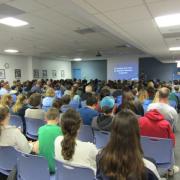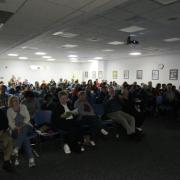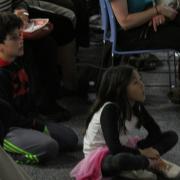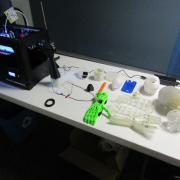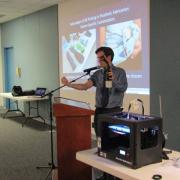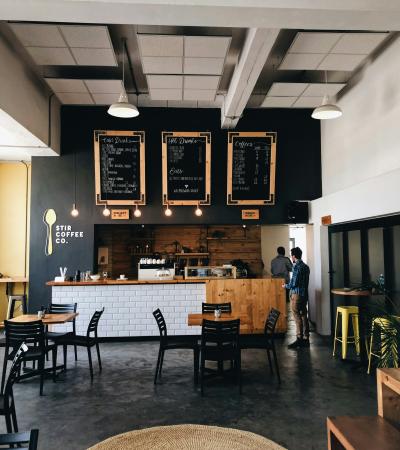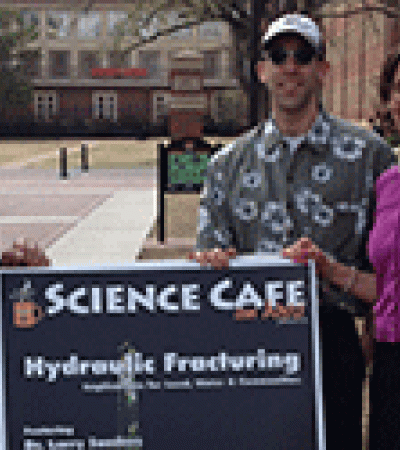Science in St. Louis is an ongoing program series held at St. Louis County Library (SLCL). This program features local scientists and their research projects. While many of the topics discussed can be quite complex, the goal of this program is to present science in a fun and informal manner that encourages children and adults to become interested in science.
Since starting in 2015, there have been 16 programs with an average of 82 attendees per program. Topics have included Missouri’s Ozark dinosaurs, forensics at the St. Louis County Crime Lab, and 3D printing in medicine.
Advanced Planning
Kaitlyn Faries, a chemistry Ph.D. Student at Washington University in St. Louis (WUSTL), created this program in 2014. Originally, the program was held on campus at WUSTL and attracted a modest crowd. Faries wanted the series to reach a broader audience and contacted SLCL’s adult programming manager, Stacey Lewis, in the summer of 2015.
Faries felt that SLCL would be a perfect partner for the program series because it is a center for learning, accessible to people in different communities, and already hosts many successful programs. Since this program series fits with the library’s mission of enriching minds, expanding lives and expanding perspectives, Science in St. Louis became a regular program series at SLCL starting in October 2015.
The goal of the series is to make science more accessible to the St. Louis metro area. The series rotates between different SLCL branches located throughout St. Louis County in order to reach as many people as possible. Attendees of all ages have enjoyed learning more about science happening in their community.
Marketing
SLCL promotes each Science in St. Louis program through social media, the SLCL website, online calendar, print fliers available at library branches and e-blasts. Our Science in St. Louis partner, the Academy of Science of St. Louis, also promotes the series on its website calendar and through e-mail to constituents. (View sample marketing materials under Attachments at right.)
Additionally, Faries designed Science in St. Louis t-shirts that are given away at programs and provide great promotion for the series. We believe the marketing of the series has been very successful, considering the large attendance numbers at Science in St. Louis programs.
Budgeting
At the start of the series in 2015, the program was funded through an Education and Outreach Mini-grant from PARC (Photosynthetic Antenna Research Center), a research institution in St. Louis. Since then, the program has received a St. Louis Project Grant from WUSTL’s Gephardt Institute and additional support through the Academy of Science of St. Louis. The St. Louis Project Grant was re-awarded to Science in St. Louis in 2017. This is the first time a program has ever been awarded twice through this particular grant.
SLCL provides only in-kind funding through staff time, programming space and publicity. In the future, if there is ever a need for cost-cutting, possible aspects that could be cut include refreshments, attendance prizes and thank-you gifts for the speakers.
Our grant awards are as follows:
- Science in St. Louis is based upon work supported as part of the PARC, an Energy Frontier Research Center funded by the U.S. Department of Energy, Office of Science, Office of Basic Energy Sciences under Award Number DE-SC0001035
- National Science Foundation for support awarded to Kaitlyn Faries through the Graduate Research Fellowship Program under Award Number DGE-1143954.
- Capacity Building Grants for St. Louis Projects from the Gephardt Institute for Civic & Community Engagement at Washington University in St. Louis.
Day-of-event Activity
Each Science in St. Louis program has very little set-up required. The room is organized auditorium style, with chairs facing the front of the room toward the podium where the speaker presents. There are also tables positioned on the side of the room, which have complementary refreshments, related library materials such as books and DVDS on the topic being presented, and promotional handouts.
The speaker presents using a PowerPoint presentation with the equipment set up by a PARC staff member. PARC is also responsible for videotaping the lecture, which is made available online following the program.
Staffing for the program is fairly minimal. SLCL usually has one to two staff members on hand to assist with operations before, during and after the program. Faries attends each program and helps with set-up and operation of the program. She also runs a raffle at the conclusion of the lecture in which attendees can win a variety of prizes, including a Kindle.
Program Execution
This series seeks to educate people in the St. Louis region on the latest local science research. The community has expressed interest in programs relating to science and technology throughout the years, and Science in St. Louis is the perfect response to this need.
Through each Science in St. Louis seminar, attendees discover how local science research affects their own lives. The programs are presented in a fun and informal manner, which makes the presentations appealing to people of all ages and knowledge levels.
Program topics have included the following. (For more examples, view the fliers under Attachments at right.)
- Monster in the Hollow — The Story of Missouri's Ozark Dinosaurs
- An Introduction to Carbon Capture, Utilization and Storage
- Fighting Antibiotic-Resistant Superbugs Across Diverse Habitats
Each program consists of a one-hour lecture, an audience question and answer session, and a raffle for various prizes. Attendees also take a survey at the conclusion of the program where they can rate their satisfaction with the event. The feedback received from the surveys has been overwhelmingly positive. People have enjoyed the variety of programs offered and have been thrilled to learn more about the science happening in their own community.
Since beginning in October 2015, 16 Science in St. Louis programs have been held at SLCL. A total of 1,312 people have attended these programs, an average of 82 people per program. Through the outstanding attendance numbers, our goal of reaching people throughout St. Louis County has definitely been achieved.
The impact of the program is assessed and measured through a paper survey at the conclusion of the seminar. The survey measures how participants learned of the program, reasons for attending, whether or not they have attended other Science in St. Louis seminars, their satisfaction with the program, if the seminar deepened their understanding of the topic discussed, and demographic information such as occupation, age and zip code. The results showed that the majority of attendees were “very satisfied” or “satisfied” with the seminar, and the bulk of respondents shared that the program deepened their understanding of the topic. The survey also showed that attendees came from all over St. Louis County and beyond to attend the program, and many different age groups were in attendance.
Advice
Collaboration with others in the community has been the key factor to the success of this program series. SLCL was fortunate to be introduced to the program by Ph.D. student Kaitlyn Faries. Since Faires is working on her Ph.D. at WUSTL, she has many contacts at the school that have been able to present on their latest research free of charge.
SLCL has also partnered with other science-related organizations in the area to bring in diverse speakers and to promote the program series. Science in St. Louis has featured researchers from Washington University, University of Missouri St. Louis, the St. Louis Zoo and Monsanto.
Science is everywhere, and even if a library does not have a large research university nearby, there are plenty of other possibilities for interesting presentations. Libraries could reach out to science-related professionals who work at their local zoos, parks, conservation centers, gardens, wildlife rescues, hospitals and more. Also, many professors seek presentation opportunities as part of their research. Even if they are not near a library, they could present their work remotely through a video conference.

